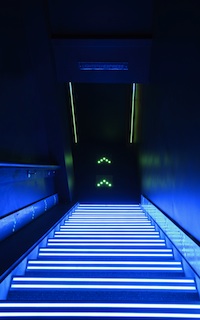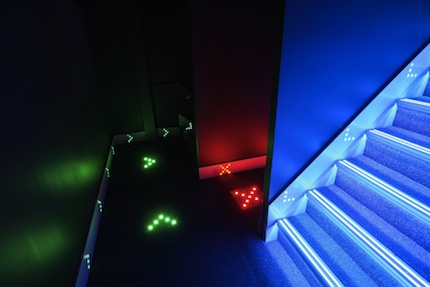Upper Iowa U To Install 'Intelligent' Emergency Lighting System
- By Dian Schaffhauser
- 05/31/11

With the Stairfinder system, green arrows identify safe passages in an emergency evacuation. |
A Fayette, IA-based university with about 6,800 students is implementing a new feature that will light up escape routes in stairways in the event of an emergency. Upper Iowa University (UIU) has signed a deal with Lightstep Technologies, a Belfast, Northern Ireland company, to put in place Stairfinder, an "intelligent evacuation system."
In a building equipped with Lightstep products, escape routes are illuminated and can be rerouted depending on the type of emergency and location of the danger. Safe routes are lighted in green; unsafe routes are crossed with red x's. The company said the lights remain visible even in smoke-filled environments.
"My background is in fire safety, and I knew immediately that UIU had to explore acquiring this technology," said university President Alan Walker. "In any fire, the key issue is always time. How quickly can you completely evacuate the building safely? The same is true for a building affected by any natural disaster. "
This installation, which the company said will be the first one to take place in the United States and the first one done in a university setting, will help the school deal with daytime and nighttime evacuations. The three newest buildings on campus will be retrofitted with the technology in fall 2011.
According to Lightstep Executive Chairman Kieran Patterson the Stairfinder provides a twin active illuminated strip of light that offers a "vastly superior indication of the edge of each stair compared with alternative technology such as photoluminescence (PL)." He added that as an option the product can incorporate PL technology within its enclosure to provide persistent lighting following a power failure.

Red Xs mark walkways to be avoided. |
Fitting the Stairfinder to a stairway requires fastening an appropriate length of product to each stair nose and fitting "mini-trunking to carry the safety extra low voltage (SELV) supply to each stair." The SELV supply is connected to an isolated transformer that's wired into the building's electrical system.
There are four ways to activate the Stairfinder in an emergency, Patterson explained. "The primary and preferred activation comes from the volt-free auxiliary output from a building management system or fire alarm panel. If the system is powered from an emergency power circuit, then it can be triggered active by the power failure that triggers the emergency power. If it's not possible to integrate directly with a building fire alarm panel, then it is possible to trigger the system active by means of an acoustic coupling to the building's fire alarm sounders. [Finally,] any mechanical switch can be used to trigger the system active--this could be a break-glass switch, or a door or window sensor, or a simple master control switch accessible to a building supervisor."
"We believe all residential campuses should be exploring the Lightstep options to enhance campus safety, and we are proud to be the first university in the world to begin this work," UIU's Walker said, adding that the campus will become a demonstration site for Lightstep. In return, the company has defrayed costs and made the technology "more affordable."
About the Author
Dian Schaffhauser is a former senior contributing editor for 1105 Media's education publications THE Journal, Campus Technology and Spaces4Learning.